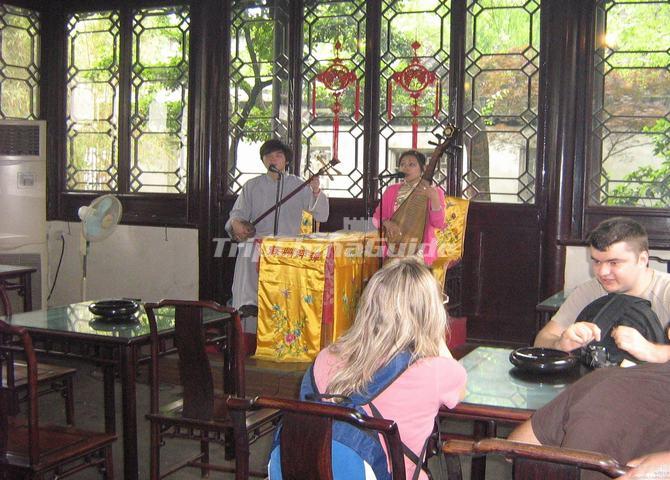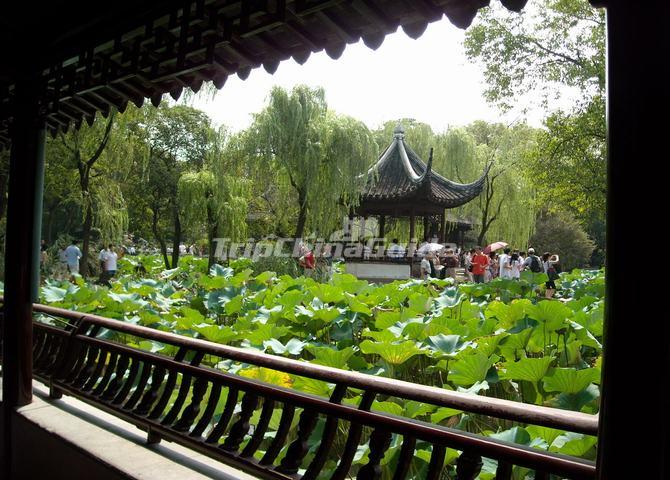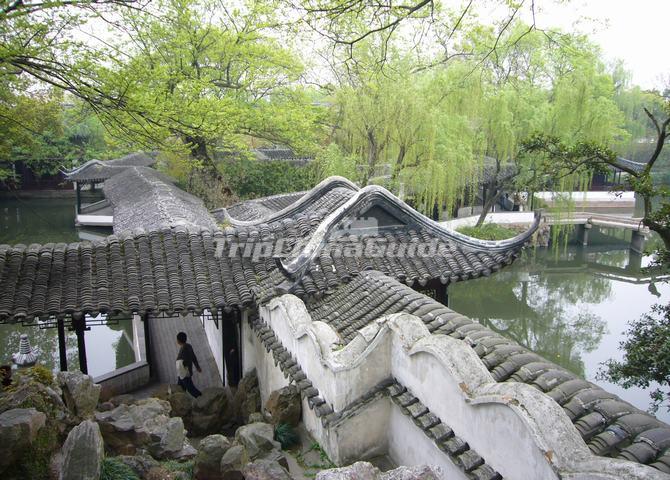Humble Administrator's Garden
Covering 51,950 square meters, the Humble Administrator's Garden is the largest of all classical gardens in Suzhou. It is centered upon the broad expanse of a lake, making up about one fifth of the total area. With well spaced buildings, the garden landscape and waterscape are simple, extensive and natural, possessing the traditional appearances of the Ming Dynasty. It is divided into three parts; the eastern, middle the western parts. The house lies in the south of the garden.

The middle part is the cream of the garden with marvelous mountains, clear water, exquisite buildings and exuberant trees and flower reminiscent of the scenery in the south of the Lower Yangtze. Lying here and there to the south of the lake are garden buildings and courts in cluster. On an east-west axis there's the Hall of Drifting Fragrance in the middle, flanked by the Loquat Garden Court, the Malus Micromalus Makina court, the Poeny Pavilion, the Listening to the Sound of Rain Pavilion, the small canglang, "A Pure Mind Thinks Deep", and the Magnolia Hall. Rising from the lake are the east and west hills made from a mixture of earth and rocks, and covered with trees. The Prunus Mume Pavilion and the Orange Pavilion stand atop of the hills. By the side of the lake there are forsythias gently stroking the surface of water, and bringing about delightful effects of nature. Much of the surprise comes from the disposition of the Fragrant Isle, the pavilion in lotus breezes and the Mountain-in-View Tower to the west of the lake. from the secluded pavilion of Firmiana Simplex and Bamboo one is able to catch sight of the pagoda of paying debts of gratitude in distance. The picturesque scene of the pagoda mirrored in water is an example of the garden technique called "borrowed view from afar".

The buildings in the western part of the garden are properly arranged by the lake. To the south of the lake is a big mandarin duck's hall with two halves. The northern half is named "the Hall of 36 pairs of mandarin ducks" and the southern half "the hall of 18 camellias ". built to the west of the lake are the Inducalamus Pavilion, the "With Whom Shall I Sit"? pavilion, the Floating Green Tower, the Stay-and-Listen Pavilion, the Pagoda Reflection pavilion. Going up and down and in a zigzag, a unique veranda over the water is a structure built along the wall to the east of the lake. The Good-For-Both-Families Pavilion on the top of the hill overlooks the middle and western parts, another example of the garden technique called " borrowed view from near".

Decorated with the Cymbidium Virens Hall, the lotus pavilion, the Celestial Spring Pavilion, the Far Away Looking Pavilion and the All blue Pavilion, the eastern part of the garden has verdant hills with pine and bamboo, distant islands encircled by winding streams, and an extensive area of grass, flowers and trees.
Glowing out of the mud, lotus blooms still keep themselves pure and clean. The farther theirs mell drifts the purer it becomes. A good number of buildings in the garden are named after lotus blooms, often known as "a true person of the virtue "among flowers, such as the Hall of Drifting Fragrance, the Lotus Pavilion, the pavilion in the Lotus Breeze, and the Stay-and-Listen Pavilion, expressing the theme of the whole garden--to be pure as lotus blooms.

Lying to the south of the garden is the house, which is the typical residence in Suzhou. On a north-south axis there are four successive buildings, namely the Sedan-Chair Hall, the Reception Hall and two two-storeyed buildings. To the east of the axis are the Mandarin Ducks' Hall with flower-basket decoration, the Flower Hall and the Four -Sided Viewing Hall.
The Humble administrator's Garden boasts altogether 48 different buildings, 101 parallel couplets and door plateaux, 40 stelae, 21 precious old trees, namely Wistaria, Sabina chinensis, Pterocarya stenoptera, etc. falling into 13 different catalogues, and over 700 bonsai (potted landscape) kept in the Bonsai Garden in the western part of the garden, representing the Suzhou style bonsai, one of the four leading bonsai styles in china.
Address: No. 178, Northeast Street, Suzhou
Opening Hours: 7:30am-17:30pm
Entrance Fee
Low Season: RMB 50yuan (October 31-April 15)
Rush Season: RMB 70yuan (April 16-October 30)
Ask Question
Recommended China Tour Packages
In this section
- Suzhou Gate to the East
- Mountain Villa with Embracing...
- Lingering Garden
- Humble Administrator's Garden
- Guangqian Street
- Confucian Temple
- Surging Waves Pavilion
- Retreat and Reflection Garden
- Garden of Cultivation
- Twin Pagodas at Luohanyuan Templ...
- Suhzhou Embroidery
- Suzhou Kun Opera Museum
- North Temple Pagoda
- Couple's Retreat Garden
- Baodai Bridge
- See more
Find China Tours
Cities and Attractions interested in












